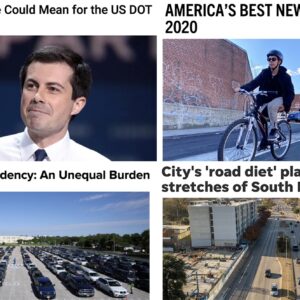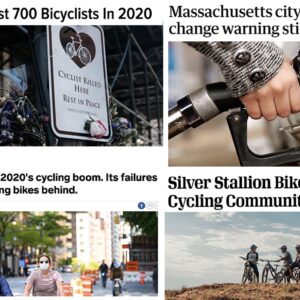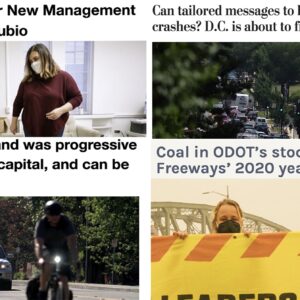Here’s the news we came across last week. Thanks to everyone who sent us links and tips.
– President Obama has signed an order prohibiting federal employees from sending text messages while driving.
– You can now download your own copy of Robert Moses’ 89 page plan for Portland’s transportation future, drawn up in 1943 with its famous plan for a network of inner-city freeways.
– The new bikesharing scheme in Dublin has run into an unexpected snag — it’s too popular. The hope was to achieve 5,000 subscribers in the first year; instead 11,000 signed up in the first two weeks.
– Few in Israel drive during the Yom Kippur holiday, celebrated last week. A radio story tells how the day turns into an impromptu celebration of bicycling, particularly for children.
– The national Distracted Driving Summit was last week, and you can find the proceedings (including video) here. Coverage includes notes and reflections on the culture of driving and some interesting technology-based proposals that are on the table. Even Fox News noticed the summit.
– A long, interesting essay calls on bicycle advocates to steer away from the all-too-common strategy of promoting bicycling only by talking about about fear, danger, and injustice. (And there’s an interesting discussion of the article going on at BikeForums.net.)
– Sarah Mirk at the Mercury thinks we should make bicycling so normal it’s boring, and tells us how.
– An article about employers who provide free bikes to encourage employees to ride to work profiles a brewery in Ashland, Oregon that had 17 workers sign up.
– The Oregonian has a write-up of local small businesses that operate by bike, or even on bikes.
– An update on the Saratoga Springs bike-to-school ban; one family continues to ride in protest, the school district may reconsider the policy.
– Bike industry leaders are increasingly stepping up to ask politicians to support bicycle infrastructure.
– Bike blogs (including this one) are included in an interesting roundup of uses of social media to make cities safer.
– Mikael Colville-Anderson of the blog Copenhagenize is on tour in the US (he’ll be in Portland soon) and has posted some really enticing photos of New York City’s new bike infrastructure.
– Forbes Magazine profiles the force behind much of this new infrastructure, NYC Transportation Commissioner Janette Sadik-Khan.
– The pedestrianization of a popular shopping street in Madrid has turned out to be great for, well, shopping.
– The Believer has published a history of the automobile, particularly of car salesmen, that reads like a eulogy.
– The Streetsblog network recently compiled photos of bike traffic from all over the country. For their next slideshow they are seeking “photos of cars hogging space in your communities — graphic examples of how they crowd out other users.”
– An LA photographer has an exhibit coming up consisting of portraits of 100 Angelenos who live carfree.





I like Mirk’s article but I think the bottom line is that Americans are getting lazier, fatter, more dependent on technology, and more entitled each year. THAT is the biggest roadblock to making cycling a mainstream transportation option.
It seems that the link to “The pedestrianization of a popular shopping street in Madrid has turned out to be great for, well, shopping” is broken. I’d really like to read that one!
Fixed the Madrid link — thanks for pointing that out.
re: “making it illegal for federal employees to send text messages while driving.”
The linked blog post (which is a quote from Democracy Now) says “President Obama has signed an executive order to prohibit federal employees from sending text messages while driving”
My interpretation is that it’s not illegal for federal employees to text while driving, but that it is now prohibited under the employment policy of the federal government and is subject to reprimand.
So not a convictable offense, but a scolding and possible firing.
Thanks, Ben, good point — I edited that item to “prohibiting.”
Pedestrianization would work well for the busiest parts of Hawthorne. I’m certain there are numerous other spots in Portland where it would work as well. These pedestrianized streets were one of my favorite aspects of Spanish cities when I was there 10 years ago. I saw them in Madrid, Seville and even Jerez De La Frontera (a population of about 200,000). So they can work in any size city. Spanish cities do have the advantage of very dense mixed use urban centers, but I still think it can work here.
In Seville one vibrant street I remember had canvas stretched between the buildings for shade (it does get hot there). Perhaps Portland could do something appropriate to our climate. Maybe a glass roof to keep out the rain and let in the light.
Elly, thanks for fixing the link. At the last Last Thursday on Alberta, I talked with several people about how great it was and I told them, “It could be like this all the time if we didn’t feel the need to sacrifice this street to the almighty auto.” The responses I received were mostly something along the lines of, “Yeah, but none of these businesses could make any money then.” Too bad I didn’t have a copy of this article to show them. I suspect many of the businesses along Alberta would make more money if that were made into a pedestrian/bicycle corridor. In fact, it was amazing how quickly the crowd dissipated once the streets were opened back up to cars. All those people, who were having a great time spending money on local arts and crafts, and in bars and restaurants, went on home. There was a lot of energy and a great party atmosphere, but then along came the security guards, walking in a big sweep pattern, yelling, “EVERYBODY ON THE SIDEWALK! STREETS ARE OPENING BACK UP! EVERYBODY ON THE SIDEWALK!” And right behind them was a line of cars driving two miles an hour to get through (nevermind that they could have driven any side-street or Killingsworth a few blocks north if they wanted a major street). The fun atmosphere and the energy that had been there quickly drifted away- and along with it went all of those people who would otherwise have been out there having fun and spending money. Sorry to rant, but I’m amazed that people can see how great (and economically viable- perhaps even economically preferable a car-free community (or at least street or neighborhood) can be, but then complacently say, “Oh, it’s 11pm, better give the streets back over to the cars.Everybody get out of the way, can’t hinder traffic!” Traffic driving through-not spending money. Sorry to keep harping on the money, it’s just that that’s so often the argument against car-free space. But why aren’t we demanding more car-free space? Not the whole city necessarily, just little pieces of it. Maybe there aren’t enough people who want it? I don’t know. Again, sorry for ranting- I’ve just seen how good it can be.
(emphasis mine)
So, you haven’t actually read it then, have you?
Freeways actually make up a very small portion of the plan.
Thanks, Valkraider, you’re right, I haven’t read it yet (it’s downloaded and waiting). I’m glad that you have and were able to point out the error — I’ve edited the blurb to assume less of the worst. 🙂
Ryan G and BicycleDave:
They tried something like this in Eugene, where I grew up and lived until 1989. The main downtown core was closed to cars and turned into an outdoor mall. And the downtown slowly died … it’s been opened to auto traffic again for years, and the downtown has recovered, from what I understand.
So what works in Europe, or even temporarily in the USA, may not work long-term here. I think it was even successful for a while in Eugene, it just didn’t have legs. Of course, gas was cheap back then, and Eugene didn’t have the kind of transit service we do here, so people there were inclined to go where they could drive closer, even though Eugene had plenty of free parking downtown.
Bent Bloke,
I agree it will be harder here than in Europe where cities are more dense and have lot’s of people living in and near the core of the city. I don’t know what went wrong in Eugene, but I think you’d want to start with a place that already has sidewalks overcrowded with shoppers like Hawthorne. One of the spots I saw it work well was a little diagonal piece of street that wasn’t all that useful for traffic anyway. Hawthorne doesn’t fit that criteria, but maybe there’s a way to route autos around a short stretch of closed Hawthorne or a better spot in another neighborhood or downtown.
I’m sure we can figure out how to do it here. It may be another 20 years before Portland is dense enough or it may take some laws discouraging big box stores and encouraging small locally owned shops, but we can do it here.
If you look at the amount of land we’ve ceded to the automobile it just makes all kind of sense to take some of that back for people.
One block that’s been talked about as a potential carfree plaza for years is SW Ankeny between 2nd and 3rd Aves. It’s a one-way street that sees very little traffic and has something like 6 parking spots.
Shift held the Carfree Days street fair there in 2006 and business owners said they were were quite keen to make the street a permanent plaza — there were talks of cobblestones and a fountain. I’m not sure what happened to that plan, but maybe it’s a good time for someone to step up and give it another push.